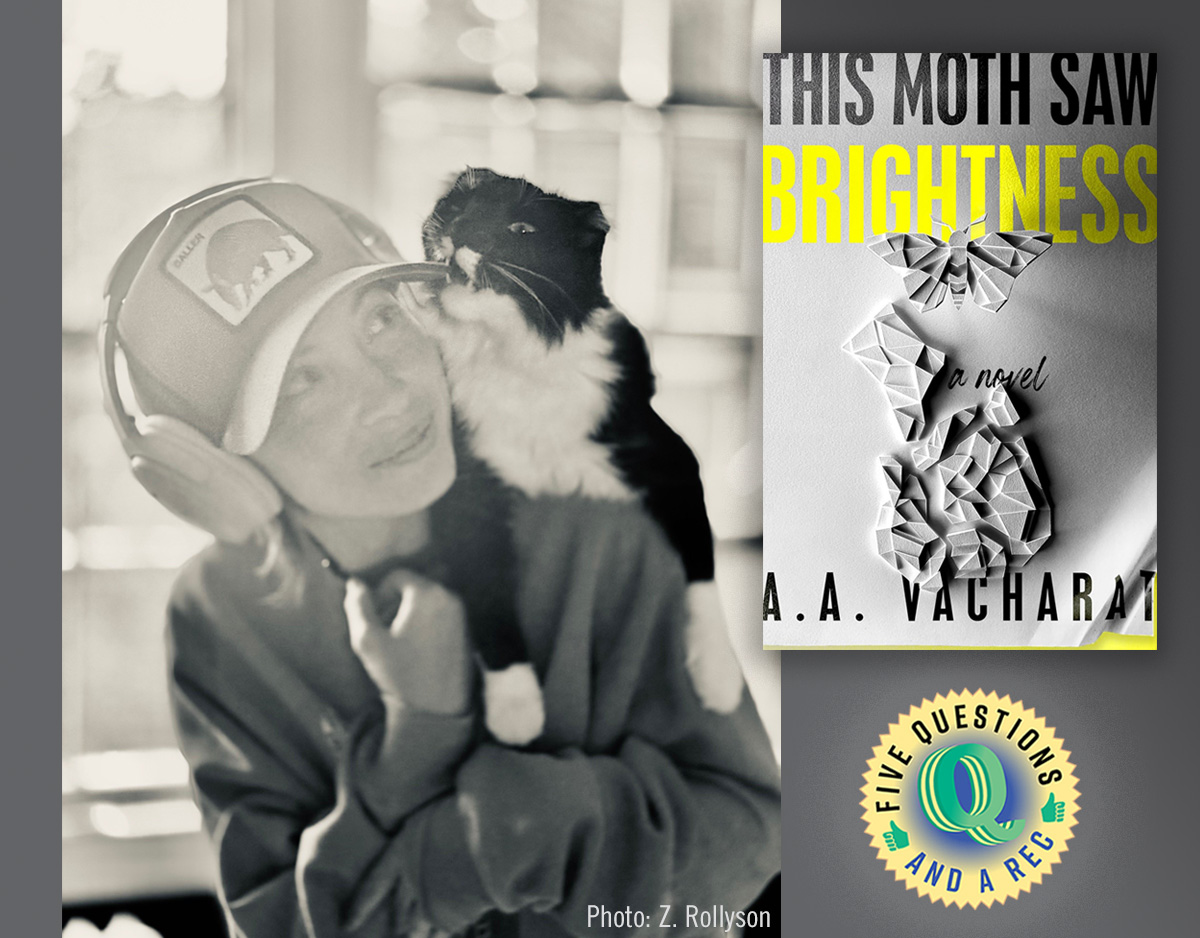Author A. A. Vacharat on YA Debut ‘This Moth Saw Brightness’ | 5 Questions and a Rec
In this Q&A series, SLJ poses five questions and a request for a book recommendation to a debut YA author. A. A. Vacharat shares about This Moth Saw Brightness in this latest installment.

In this Q&A series, SLJ poses five questions and a request for a book recommendation to a debut YA author. A. A. Vacharat shares about This Moth Saw Brightness in this latest installment.
1. Congrats on your YA debut! How would you describe your book to readers?
I’ve found “strange” encapsulates everything most succinctly.
“Devastatingly timely” is also accurate, unfortunately.
2. What drew you to YA to tell this story?
YA allows risks. You have people that are ready for more, but they don’t know what “more” is. Young people don’t have expectations for what a book should look like, or if they do, they don’t mind—I like to think—those expectations getting blown.
It’s also a story about figuring out what you believe and what you care about and what that caring looks like. It’s about figuring out your boundaries of self. For me, that’s so much of what high school and college was.
3. What, if anything, surprised you while writing it?
That I have things I want to say! I grew up determined to not care about anything “political” or “issue-y.” But over the 13 years of poking at this book—during which, of course, many other things were happening—I found that to write something I liked, I needed to care about what the story was saying. Gasp.
Retrospectively, this all feels so silly. I mean, I went to a college where the cool thing to do on Saturday nights was camp out in the library lobby and debate ethical conundrums. So of course, I always cared, and there were always things to say; perhaps the greater surprise was that I could be the person to say them.
(As I’m writing this, now, I’m realizing that MOTH’s narrator, D, goes through the same journey over the course of the novel. Huh!)
4. Tell us more about the characters. Which character do you most identify with and why?
In college, I used this question for starting conversations: “Which cereal represents you and why?”
I liked this question in part because it made it easy to identify who wasn’t worth conversing with (anyone who answered with their favorite cereal, which was not the question!), and also because I knew and liked my own answer.
I was Lucky Charms, because people only remembered it for the colorful marshmallows, despite its more substantial majority.
Back then, I was effervescent and strange (and, if the above anecdote is any indication, rather difficult), and people often told me that they longed to shrink me down and store me in a display box on their bedroom bookshelf as a cute mood-boosting accessory. I was manic-pixie-dream-girled.
In the novel, Jane is my anti-manic-pixie-dream-girl. On the surface, she exhibits many classic MPDG characteristics—which, side note, often feels like the way the media has, perhaps unwittingly, included coded autistic women. But as the novel progresses, D, and hopefully the reader, begins to see past this to Jane’s complicated interior life and justice-driven actions and realize that she exists entirely independently from D’s story. She isn’t just colorful marshmallows. She has her own voice and her own things to say.
5. What do you hope readers will take away from this book?
Gah! I always worry that hoping readers will “take something away” will make them feel pressured to do so! It’s a lofty expectation. Be changed! Be impacted! Do anything more than simply read through the pages!
But if I suspend that worry momentarily, hmm. I would love one reader out there to take away: the complexity of what people believe and the roads they travel to believe those things.
Or, a better understanding of and acceptance of autism.
Or, a new awareness of their own tolerance—or lack thereof—for ambiguity, not-knowing-ness, the waiting for information and even promises that you’ll never have the answers.
But also, readers: Please don’t feel pressured to take away any of those things! Or anything at all!
The Rec: Finally, we love YA and recommendations—what’s your favorite YA book you've read recently?
I recently read The Red Car to Hollywood by Jennie Liu. I loved the spotlight on the history of Asians in America in the 1920s. It’s a part of history I don’t know much about, and I probably should! It left me wanting to learn more.
RELATED
The job outlook in 2030: Librarians will be in demand
The job outlook in 2030: Librarians will be in demand
ALREADY A SUBSCRIBER? LOG IN
We are currently offering this content for free. Sign up now to activate your personal profile, where you can save articles for future viewing






Add Comment :-
Be the first reader to comment.
Comment Policy:
Comment should not be empty !!!